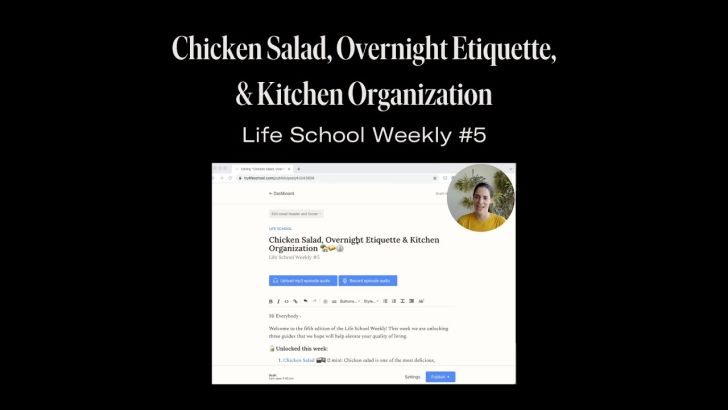Today’s lesson is 1,064 words, a 4 min 15 sec reading time. Subscribe here.
📍Introduction:
The word salad comes from the Latin word salar, which means “to salt.” It is believed that the original salad was simply greens sprinkled with salt. These days we tend to season our salads, but also dress them up a bit more, namely with dressing! Dressing refers to a sauce or seasoned mixture that adds flavor to a dish.
Today most Americans use bottled dressing on their salads. While bottled dressing is convenient & long-lasting, we highly recommend homemade dressing to make your salads sing. Homemade dressing has a brightness to it that is hard to replicate with bottled. Its texture is lighter without stabilizers and preservatives. The delicate flavors - for example, of herbs and spices - can be tasted more. When dressing sits for longer than a week, it tends to lose those nuanced notes.
While some dressings need a lot of labor & ingredients, others are simple to memorize and use items that are typically on hand.
You can make one at the beginning of the week and use it for several salads. By switching up the weekly dressing, you ensure that you don’t get sick of any one flavor profile.
Go ahead and clear out those old bottles sitting in your fridge door. Homemade dressing is going to knock your socks off. 🧦🤩
📝 Notes, Tips & Tricks:
General
There are two main types of salad dressing:
(1) Vinaigrette: an emulsion (incorporated mixture) of oil & vinegar. Often flavored with herbs, spices, salt, sugar, etc.
(2) Creamy: typically based on mayonnaise (an emulsion of egg yolk & oil), or fermented milk products (e.g., yogurt, sour cream)
Heavier/sturdier salad greens benefit from a creamier/thicker dressing. Conversely, more delicate lettuces are best paired with a brighter, lighter dressing. Think kale caesar vs. little gems with vinaigrette. A heavier dressing may overpower and prematurely wilt delicate greens, whereas a lighter vinaigrette may not be hearty enough to match big, crunchy lettuce.
Store-bought dressing: Pros include convenience, shelf-life, variety, and dependable flavor. Cons include being more expensive than homemade, less healthy (e.g., added sugars), and not as fresh-tasting (due to stabilizers, emulsifiers, dyes, & preservatives).
If you are optimizing for convenience, we recommend purchasing some higher-end dressings with limited chemicals and stabilizers. Try to use them up within a month. Note that many grocery stores have their own fresh, homemade dressings in the deli section.
Homemade dressing: Pros: better taste, cheaper, fewer stabilizers, more vitamins & minerals and you can create endless combinations to suit your taste. Cons: time-consuming, need to have ingredients on hand, and spoils faster.
Ingredients
Keep dressing staples stocked (e.g., olive oil, lemon, vinegars (e.g., white, apple cider, balsamic), mayonnaise, garlic, kosher salt, pepper, mustard)
If you like creamier dressings, keep some dairy stocked (e.g., buttermilk, sour cream, yogurt, creme fraiche)
For herb lovers - you can use many herbs interchangeably. Try using whatever you have on hand (e.g., parsley, basil, dill, cilantro, thyme)
Alliums (e.g., scallions, chives, shallots) add depth and complexity to dressings. To minimize the “heat” of these, macerate them in vinegar or a little ice for a few minutes before adding to your dressing.
While it’s tempting to default to olive oil, not every salad works best with that flavor profile. Give a shot to some more neutral fats like avocado or grapeseed. If you use a nut oil, dilute it with a neutral oil.
To add garlic flavoring to a vinaigrette, peel & smash a clove and let it sit in the oil for about 30 min. Remove the clove before storing.
Preparing:
Blended vinaigrettes will stay emulsified longer than whisked or shaken ones
When adding flavors to dressing (e.g., garlic, shallots), allow them to soak for ~30 min so flavors can meld
Chopped herbs should be added at the very end
For an appetizer salad, it can be fun to pair ingredients in the mixture with those coming in the main course. For example, if you have an Asian-style stir fry, you might add a little sesame oil or peanut butter to the dressing. If serving Italian style (e.g., lasagna, pasta), you could put in some fresh or dried oregano.
There are many ways to fix unbalanced dressing.
Too sweet: try adding some salt or umami flavor (e.g., soy sauce, tahini, capers, miso).
Too acidic: add something creamy (e.g., peanut butter, tahini, avocado, extra oil).
For too salty: add some sugar (e.g., honey, fruit juice, maple syrup or a pinch of brown sugar).
Too bland: can benefit from a splash of lemon or some chopped herbs.
You can always simply double the batch, and only add the ingredients other than the one with overpowering flavor.
Different kinds of vinegar have different levels of acid. Start with less than you think you need because it’s hard to cut that acidic taste once it’s overpowering
To stride ahead on salad prep, make a dressing or two each week, store them in a jar, and use throughout the week.
To emulsify the dressing gradually whisk the oil into the acid - or put everything in a jar and shake.
Emulsifying dressing is vital for maintaining the consistency of flavor in the salad. If you simply stir the dressing, it will separate inside the salad. This will leave you with some oily greens, and others that are too acidic.
Mustard is a very effective emulsifier. Add just a little if you don’t want the flavor to dominate, or add a bit more for a more pronounced mustardy flavor.
Tossing:
Ensure that lettuce is bone dry before dressing to ensure it sticks. Nobody likes wet salad resting in a pool of dressing.
In a severe time crunch? No need to make a proper dressing. Toss the greens with acid (e.g., lemon juice, vinegar), then add some oil, salt, and pepper. Taste and adjust.
📓 Flavorings Reference Guide:
Spice: dijon mustard, chili flakes, ginger, horseradish
Sweet: orange juice, honey, maple syrup, agave, sugar
Sour: any citrus or vinegar, fermented items such as pickled onions
Salt: anchovies, capers, olives, soy sauce, miso
Creamy: mayonnaise, yogurt, buttermilk, sour cream, blue cheese, tahini, crème fraîche
Herbs (soft best): basil, chives, cilantro, dill, lemon balm, mint, parsley, tarragon, marjoram
Other: citrus zest, shallots, red onion, spices such as cumin or coriander
🎓Further Study:
————-————-————-
🎧 Prefer to listen? Subscribe on iTunes, Spotify or Overcast.
💡 Have ideas for what we should teach next? Fill out this survey.
📚 Want to learn more? Check out our Table of Contents or Subscribe










